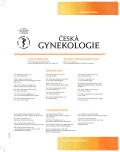Uterine rupture during pregnancy and delivery: risk factors, symptoms and maternal and neonatal outcomes – restrospective cohort
Authors:
V. Andonovová; Lukáš Hruban
; Romana Gerychová; Petr Janků
; P. Ventruba
Authors place of work:
Gynekologicko-porodnická klinika LF MU a FN, Brno, přednosta prof. MUDr. P. Ventruba, DrSc., MBA
Published in the journal:
Ceska Gynekol 2019; 84(2): 121-128
Category:
Retrospektivní studie
Summary
Objective: To analyze cases of uterine rupture during pregnancy and delivery. To report risk factors, maternal and neonatal outcomes.
Design: Restrospective cohort study.
Setting: Department of Obstetrics and Gynecology, Masaryk University, University Hospital Brno.
Methods: This study used data from medical records of 36 195 labours between 2011–2016 in the Department of Obstetrics and Gynecology Masaryk University Hospital Brno. We identified all cases of complete and incomplete uterine rupture diagnosed during pregnancy, delivery and puerperium. We analyzed risk factors, symptoms and signs and maternal and neonatal outcomes.
Results: We identified 15 uterine ruptures. Three cases occurred during pregnancy in absence of labour, ten cases in association with delivery, one case during puerperium and one case of uterine rupture was associated with induction of abortion in the 2nd trimester. Eight patients had a previous cesarean section. Other uterine surgery was reported in history of four cases, including myomectomy, perforation of uterine fundus during hysteroscopy, curretage. Three patients had unscarred uterus. Most of the cases presented with abnormal fetal heart rate tracing, abdominal pain, vaginal bleeding and hypotension. There were two perinatal deaths associated with uterine rupture and perinatal asphyxia was observed in five infants. No mother died in association with uterine rupture. Estimated blood loss higher than 1000 ml occurred in 11 cases. Three patients underwent hysterectomy.
Conclusion: Overall prevalence of uterine rupture during pregnancy and delivery was 0,04%, in women with previous cesarean section was 0.2%, in women with unscarred uterus was 0.08‰. Suspicious fetal heart rate tracing and acute abdominal pain are the most common symptoms. Adverse neonatal outcomes were identified in seven cases.
Keywords:
uterine rupture – scarred uterus – perinatal outcomes
Zdroje
1. Al-Zirqi, I., Daltveit, AK., Vangen, S. Infant outcome after complete uterine rupture. Am J Obstet Gynecol, 2018, 219(1), p. 109.e1–109.e8.
2. Al-Zirqi, I., Daltveit, AK., Forsen, L., et al. Risk factors for complete uterine rupture. Am J Obstet Gynecol, 2017, 216(2), p. 165.e1–165.e8.
3. Birth after Previous Caesarean Birth, Royal College of Obstetricians and Gynaecologists: Green-top Guideline No.45, February 2007.
4. Bujold, E., Mehta, SH., Bujold, C., et al. Interdelivery interval and uterine rupture. Am J Obstet Gynecol, 2002, 187(5), p. 1199–1202.
5. Fitzpatrick, KE., Kurinczuk, JJ., Alfirevic, Z., et al. Uterine rupture by intended mode of delivery in the UK: a national case-control study. PLoS Med, 2012, 9(3), p. e1001184.
6. Furey, EA., Bailey, AA., Pedrosa, I. Magnetic resonance imaging of acute abdominal and pelvic pain in pregnancy. Topics Magnetic Resonance Imaging, 2014, 23(4), p. 225–242.
7. Gibbins, KJ., Weber, T., Holmgren, CM., et al. Maternal and fetal morbidity associated with uterine rupture of the unscarred uterus. Am J Obstet Gynecol, 2015, 213, p. 382.e1–6.
8. Holmgren, C., Scott, JR., Porter, TF., et al. Uterine rupture with attempted vaginal birth after cesarean delivery. Obstet Gynecol, 2012, 119(4), p. 725–731.
9. Hruban, L., Janků, P., et al. Vedení porodu po předchozím císařském řezu, analýza výsledků z let 2007–2010. Čes Gynek, 2012, 77, 2, s. 127–132.
10. Hruban, L., Janků, P. Porod po předchozím císařském řezu. In Pařízek, A. Kritické stavy v porodnictví. Praha: Galén, 2012, s. 519–521.
11. Induction of labor for vaginal birth after cesarean delivery. ACOG Committee Opinion No.342. American College of Obstetricians and Gynecologists. Obstet Gynecol, 2006, 108, p. 465–467.
12. Jozwiak, M., Bloemenkamp, KWM., Kelly, AJ., et al. Mechanical methods for induction of labor (Review). Cochrane Database Syst Rev. 3:CD001233; 2012.
13. Leung, AS., Leung, EK., Paul, RH. Uterine rupture after previous cesarean delivery: Maternal and fetal consequences. Am J Obstet Gynecol, 1993, 169(4), p. 945–950.
14. Mekiňová, L., Janků, P., et al. Incidence císařského řezu a úspěšnost vaginálně vedeného porodu u těhotných po myomektomii. Čes Gynek, 2016, 81, 6 s. 404–410.
15. Roztočil, A., Velebil, P. Vedení porodu u těhotné s císařským řezem v anamnéze – doporučený postup. Čes Gynek, 2013, suppl., s. 48–49.
16. Sacco, A., Muglu, J., Navaratnarajah, R., et al. ST analysis for intrapartum fetal monitoring. Obstet Gynaec, 2015, 17(1), p. 5–12.
17. Sentilhes, J., et al. Delivery for women with a previous cesarean: guidelines for clinical practice from the French College of Gynecologists and Obstetricians (CNGOF). Eur J Obstet Gynecol Reprod Biol, 170, 2013, p. 25–32.
18. Sturzenegger, K., Schäffer, L., et al. Risk factors of uterine rupture with a special interest to uterine fundal pressure. J Perinat Med, 2017, 45(3), p. 309–313.
19. Thisted, DL., Mortensen, LH., Krebs, L. Uterine rupturewithout previous caesarean delivery: a population-based cohort study. Eur J Obstet Gynecol Reprod Biol, 2015, 195, p. 151.
20. Vandenberghe, G., Bloemenkamp, K., Berlage, S., et al. The INOSS study of uterine rupture: a descriptive multi-country population based study. BJOG, 2018.
21. Vandenberghe, G., DeBlaere, M., Van Leeuw, V., et al. Nationwide population – based cohort study of uterine rupture in Belgium: results from the Belgian Obstetric Surveillance System. BMJ Open, 2016, 6, p. 010415.
22. Xiaoxia, B., Zhengping, W., Xiaofu, Y. Clinical study on 67 cases with uterine rupture. Zhonghua Fu Chan Ke Za Zhi, 2014, 49(5), p. 331–335.
23. You, SH., Chang, YL., Yen, CF. Rupture of the scarred and unscarred gravid uterus: Outcomes and risk factors analysis. Taiwan J Obstet Gynecol, 2018, 57(2), p. 248–254.
Štítky
Dětská gynekologie Gynekologie a porodnictví Reprodukční medicínaČlánek vyšel v časopise
Česká gynekologie

2019 Číslo 2
Nejčtenější v tomto čísle
- Ruptura dělohy v těhotenství a při porodu: rizikové faktory, příznaky a perinatální výsledky – retrospektivní analýza
- Sakrokokcygeální teratom
- Porodnické vaginální extrakční operace a jejich vliv na traumatismus matky a dítěte – prospektivní studie
- Nejnovější poznatky o placentě z pohledu imunologie, tolerance a mezenchymálních kmenových buněk
